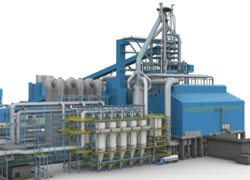Dust Removal Makes Steel Production More Efficient

<br>
The newly developed Simetal Merim process from Siemens boasts an energy recovery level 20-30 percent higher than that achieved by conventional dedusting plants.
A Simetal Merim dedusting plant is now being installed for use with a new blast furnace at a facility operated by Turkish steel producer Kardemir. The Merim (Maximized Emission Reduction and energy recovery in IronMaking) process does not require water or sludge processing facilities, which frees up space and lowers the required investment. The new dedusting plant in Turkey is scheduled to go into operation in the second half of 2013.
The blast furnace process for manufacturing crude steel creates a very dusty exhaust gas (blast furnace gas), which can be used for energy recovery by having it drive a turbine. All dust must be removed from the gas beforehand, however; otherwise the turbine blades will be damaged. Furnace dust consists mainly of fine and coarse ore particles that can be recycled after being separated.
Wet-type dedusting techniques that produce wastewater and sludge as byproducts have commonly been used up until now. Another possibility is to employ dry-type dedusting units. Their dust filters are very temperature-sensitive, however, which is why the technique is not utilized very extensively.
The newly developed Merim dry-type dedusting method enables optimal purification of the exhaust gas prior to the energy recovery process, as well as efficient separation of the dust into useful and non-useful components. With the help of a two-stage dry-type dedusting process that includes an innovative centrifugal separator and fabric filters, the Merim system improves the energy recovery performance of furnace gas turbines by 20-30 percent.
Siemens' patented Advanced Temperature Control System solves the problem of fabric filter temperature sensitivity by continually maintaining a furnace gas temperature of between 80 and 250 degrees Celsius. This ensures the fabric filters are not damaged by excessively high temperatures, and that no deposits can build up through condensation at low temperatures. To this end, the blast furnace gas is either cooled by injecting water or heated using a burner.
Merim lowers the dust content in blast furnace gas to less than three milligrams per standard cubic meter and achieves a useful dust component separation efficiency of up to 90 percent. The plant in Kardemir is designed to be able to clean a maximum of 400,000 standard cubic meters of blast furnace gas per hour.
Media Contact
More Information:
http://www.siemens.com/innovationnewsAll latest news from the category: Power and Electrical Engineering
This topic covers issues related to energy generation, conversion, transportation and consumption and how the industry is addressing the challenge of energy efficiency in general.
innovations-report provides in-depth and informative reports and articles on subjects ranging from wind energy, fuel cell technology, solar energy, geothermal energy, petroleum, gas, nuclear engineering, alternative energy and energy efficiency to fusion, hydrogen and superconductor technologies.
Newest articles

Bringing bio-inspired robots to life
Nebraska researcher Eric Markvicka gets NSF CAREER Award to pursue manufacture of novel materials for soft robotics and stretchable electronics. Engineers are increasingly eager to develop robots that mimic the…

Bella moths use poison to attract mates
Scientists are closer to finding out how. Pyrrolizidine alkaloids are as bitter and toxic as they are hard to pronounce. They’re produced by several different types of plants and are…

AI tool creates ‘synthetic’ images of cells
…for enhanced microscopy analysis. Observing individual cells through microscopes can reveal a range of important cell biological phenomena that frequently play a role in human diseases, but the process of…





















